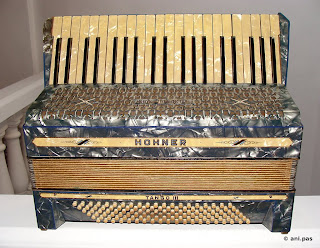In the part of the descant are located 41 piano keys, 1 push switch and 3 reed blocks (3 voices). The bass owns 120 buttons and 3 reed blocks i. e., 5 voices.
The instrument was probably manufactured only a short time; a model nearly not to find in auctions. Accordions with this name appear however still in the sale catalogues of the following decades until the early 1990s.
TANGO – that synonym of large sales records.
The renovation of this accordion required a lot of time and energy. At the time of delivery it was found in a pitiful condition. A part of the blue bellows was sticked trough i. e., the cardbox had to be renewed. A problem. Finally we found exactly the same coloured card in a stationers shop. With that, the bellows could be mended and sticked with new Kaliko. The sound of this instrument however remembered to caterwauling. Therefore we were compelled to clean all the 183 reed plates (in the tiple and the bass part) inside and outside i. e., new valves had to be sticked on them. After that, they had to be waxed again into the reed-blocks. With these actions, we succeeded in getting the instrument it's normal tuning i.e., we gave him a new life.
Hohner Modell TANGO III, Baujahr ca. 1935
Die Tangoserie I, II, III, IV und VI erscheint zum ersten Mal in den Verkaufskatalogen des Jahres 1935. Das o.g. Akkordeon ist ein weiteres interessantes Modell, das von der künstlerischen Phantasie der Erbauer der Vorkriegszeit geprägt ist.
Im Diskantteil befinden sich 41 Pianotasten, 1 Handballenregister und 3 Stimmstöcke (3-chörig). Der Bass besitzt 120 Knöpfe und 3 Stimmstöcke, die über 5 Chöre verfügen.
Es wurde wahrscheinlich nur kurze Zeit hergestellt; ein in den Auktionen seltener anzutreffendes Modell. Akkordeons mit diesem Namen erschienen jedoch auch noch in den Verkaufskatalogen nachfolgender Jahrzehnte, bis in die frühen 90ger Jahre.
TANGO – das Synonym eines großen Verkaufserfolges.
Die Renovierung dieses Akkordeons erforderte einen sehr hohen Reparatur- und Zeitaufwand. Bei Lieferung befand es sich in einem erbarmungswürdigen Zustand. Ein Teil des blauen Balges war hinten durchstochen d. h., die Kartonage mußte erneuert werden. Ein Problem. Schließlich fanden wir die farblich genaue Kartonage in einem Schreibwarenladen. Der Balg konnte somit geflickt und mit neuem Kaliko verklebt werden. Der Klang des Instruments erinnerte jedoch immer noch an ein Katzenkonzert. Somit waren wir gezwungen alle Stimmplatten (183) des Diskant- und Bassteiles von außen und innen zu reinigen, mit neuen Ventilen zu versehen und wieder in die Stimmstöcke einzuwachsen. Mit diesen Aktionen gelang es uns auch, dem Instrument die normale Stimmung zu geben, d. h., ihm wieder neues Leben einzuhauchen.
Die Tangoserie I, II, III, IV und VI erscheint zum ersten Mal in den Verkaufskatalogen des Jahres 1935. Das o.g. Akkordeon ist ein weiteres interessantes Modell, das von der künstlerischen Phantasie der Erbauer der Vorkriegszeit geprägt ist.
Im Diskantteil befinden sich 41 Pianotasten, 1 Handballenregister und 3 Stimmstöcke (3-chörig). Der Bass besitzt 120 Knöpfe und 3 Stimmstöcke, die über 5 Chöre verfügen.
Es wurde wahrscheinlich nur kurze Zeit hergestellt; ein in den Auktionen seltener anzutreffendes Modell. Akkordeons mit diesem Namen erschienen jedoch auch noch in den Verkaufskatalogen nachfolgender Jahrzehnte, bis in die frühen 90ger Jahre.
TANGO – das Synonym eines großen Verkaufserfolges.
Die Renovierung dieses Akkordeons erforderte einen sehr hohen Reparatur- und Zeitaufwand. Bei Lieferung befand es sich in einem erbarmungswürdigen Zustand. Ein Teil des blauen Balges war hinten durchstochen d. h., die Kartonage mußte erneuert werden. Ein Problem. Schließlich fanden wir die farblich genaue Kartonage in einem Schreibwarenladen. Der Balg konnte somit geflickt und mit neuem Kaliko verklebt werden. Der Klang des Instruments erinnerte jedoch immer noch an ein Katzenkonzert. Somit waren wir gezwungen alle Stimmplatten (183) des Diskant- und Bassteiles von außen und innen zu reinigen, mit neuen Ventilen zu versehen und wieder in die Stimmstöcke einzuwachsen. Mit diesen Aktionen gelang es uns auch, dem Instrument die normale Stimmung zu geben, d. h., ihm wieder neues Leben einzuhauchen.
La serie de TANGO I, II, III, IV y VI aparece ya en los catalogos de venta en el año 1935 la primera vez. Este a. m. acordeón es un otro modelo interesante, que es tambíen marcado por la fantasia de los constructores de la epoca de la anteguerra. En el tiple se encuentra 41 teclas, 1 registro corredizo y 3 soportes de voces (3 voces). La parte del bajo tiene 3 soportes de voces, que disponen de 5 voces.
Este instrumento problemente fue fabricado en un periodo solamente corto; un modelo muy raro de encontrar aun en subastas. Acordeónes con estes nombres en todo caso aparecieron aun en las decadas siguentes, hasta en los principios de los años 1990.
TANGO – el sinonimo de un éxito de ventas.
La renovación de este acordeón requerió mucho tiempo y energía. Del momento de la entrega se encontró en una condición miserable. Una parte del fuelle de azul fue perforada, se dijo que el cartón tuvo de restaurar – un problema. Finalmente este cartón fue encontrado en una papelería. Con eso, el fuelle fue remendado y pegado con Kaliko en las arrugas. El sonido, sin embargo, recordado aun a la musica de ratoneras. Por consiguiente estuvimos obligado de limpiar todas las placas de voces (183) fuera y dentro en el tiple y bajo, dotando estas con valvulas y “soldarlos” otra vez en los soportes de voces. Estas acciónes salieron bien y lo fue possible de reimplantar el acordeón una afinación normal es decir, dimos este acordeón una vida nueva.
© ani.pas



0 Kommentare:
Post a Comment